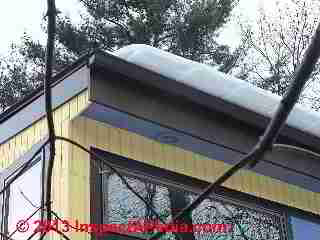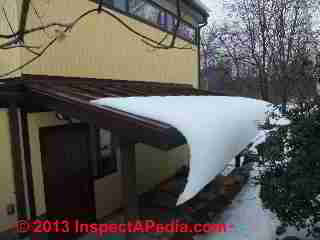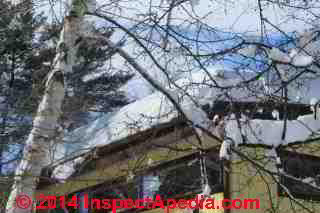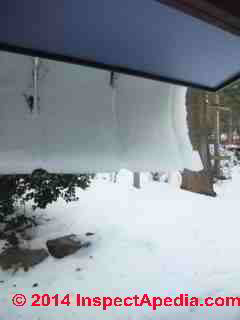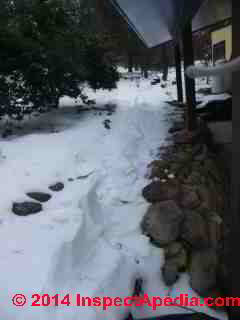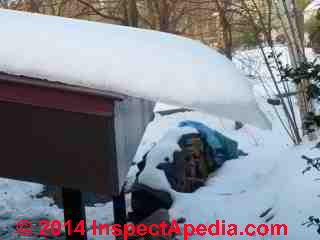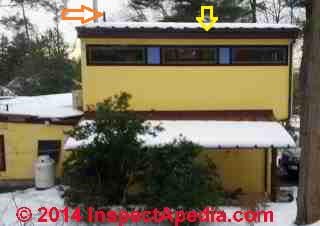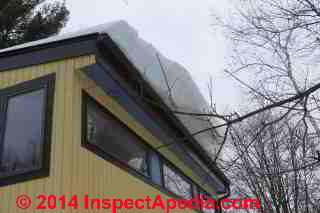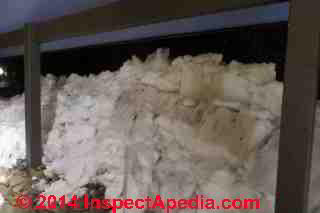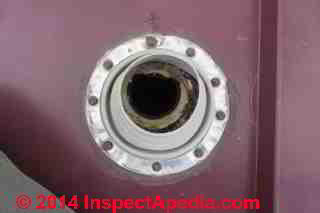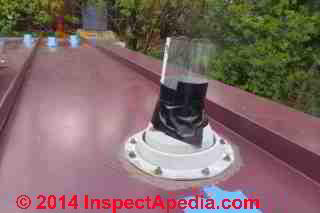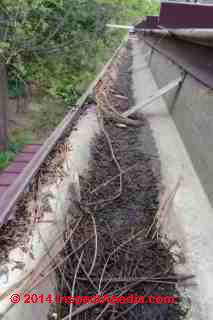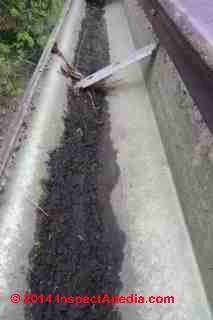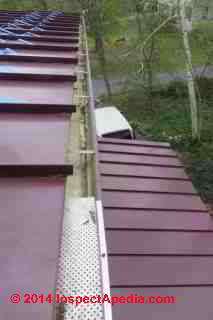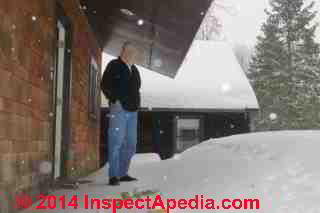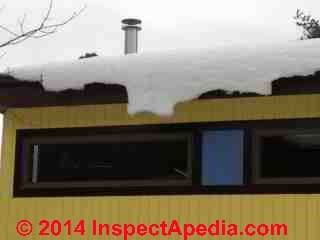 Snow Guard Failures & Damage
Snow Guard Failures & Damage
- POST a QUESTION or COMMENT about snow guards & snow retention systems on buildings
This article describes failures in snow retention systems for building roofs.
We describe several types of failures that occur including damage to the snow fence or snow brake itself, damage to the roof covering, building leaks, loss of clamp-on, glue-on or other snow guard components and of course crashes of snow and ice onto shrubs, vehicles, and potentially people who have the misfortune to be beneath the roof eaves during a sudden release of snow and ice.
This article series illustrates types of snow guards or snow brakes or other snow retention devices used on metal, rubber, asphalt, and slate roofs and we explain and illustrate in photographs just how and where these devices are attached to building roofs. We give the reasons for snow & ice retainer use and their history.
InspectAPedia tolerates no conflicts of interest. We have no relationship with advertisers, products, or services discussed at this website.
- Daniel Friedman, Publisher/Editor/Author - See WHO ARE WE?
Snow Fence & Snow Guard Damage & Failures
Snow and ice sliding off of a building are dangerous conditions. that can injure people and damage property. What is less obvious until inspecting the roof of a building that has suffered heavy snow movement and slide-downs, is that there may be damage to on-roof components as well.
The new metal roof on which snow was sitting had not been fitted with snow guards. Below we will look at more damage to this building from sliding snow. In earlier years we saw thin layers of snow projecting out of the roof edge (above left) and head an occasional soft WHUMPFF as that snow fell onto the lower roof (above right).
We thought that snow and ice might slide and fall off of this roof falling harmlessly to a lower standing seam metal roof and from there it might fall harmlessly to the ground in an area free of vulnerable shrubs and not along a walkway or path.
Below is some of the snow accumulation on the same two roofs in 2014, before there was any trouble with sliding falling snow and ice. The calm before the crash.
The thick soft snow blankets covering the upper and lower metal roofs shown above is deceiving. Changes in weather, rain, melt, freeze cycles can convert this snow covering into a very heavy, thick snow mass. N
ot every roof is accessible or even safe to try "raking" the snow off. Assuring an adequate structure of the roof combined with snow brakes or guards may be in order in these situations.
Below at left is a photograph of thick frozen snow curling over the end of the lower metal roof and at below right is a modest amount of roof snow fallen harmlessly to the ground to the left side of a covered walkway.
These relatively trouble-free conditions recurred for the first few years of the building's life - but, then, there had not been heavy snowfall, rain, freezing, and thick roof snow and ice loading.
The winter weather of 2014-2015 dumped heavy snow in areas of the Northeastern U.S. the same lower roof as shown above, sported a nice thick blanket of snow and ice (below). Given prior years' experience we weren't too worried about snow sliding off of this lower roof nor the larger upper roof above it. That was a mistake. We should have been a little worried. At below right you can see the situation: a large low-slope metal roof on an upper floor accumulates snow that's going to fall onto the lower one.
Notice my arrows pointing to that nice vertical plumbing vent on the upper roof? And the gutter on the upper roof? Hmmm.
We heard a horrible tremendous CRASH and the building shook. A huge section of snow and ice had fallen from the upper roof onto the lower one. Happily the lower roof structure withstood the impact without damage, and happily too the standing seams on the lower roof were not flattened by falling ice.
They could have been. It was time to start thinking about snow guars. CRASH! again. And again. I went out for coffee.
We visited this site again at night to notice the height of the bank of snow that had slammed down onto the lower shed roof and thence onto the ground (photo above right).
Snow that had fallen from the two roofs was now piled from ground level to nearly the height of the roof eaves.
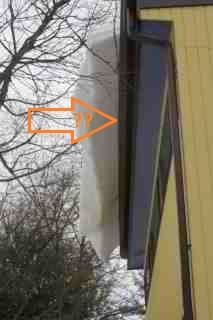 The structure withstood the crashing. And nothing vulnerable was in the path of the falling snow and ice at this building.
The structure withstood the crashing. And nothing vulnerable was in the path of the falling snow and ice at this building.
We observed (left) a thick heavy blanket of snow and ice easing slowly out past the roof edge. One might wonder just how much of that load is being taken onto the gutters affixed to the fascia board.
The condition of the two roofs and on-roof components like plumbing vents & gutters remained an open question.
The next inspection that was made of this roof was months later after snow had melted and the roof surface was dry.
Plumbing vent damage risks roof leaks and means Add Those Snow Guards
This was the first on-roof observation we made once snow and ice were clear of the roof: a bent over pluming vent. Who would have thought it? Sliding snow from the upper roof bent over this large ABS plumbing bent and broke it right off inside the roof cavity.
Notice that yellowish color at the broken end of the vent? That's foam insulation. This roof is installed over a cathedral ceiling with foamed insulation. That's not a design that tolerates water in the roof structure very well. Looks like a leak point.
The second photo (below right) shows the broken off ABS stub inside the roof cavity.
The foam insulation was found to be a bit wet around the vent and was left to dry. Had this defect gone long un-noticed rainwater leaking into the roof structure would have eventually risked a costly mold catastrophe.
We jury-rigged a temporary plumbing vent out of soda bottles, mouth down, to direct any rainfall into the vent interior (below left), giving time to cut and prep and repair the broken plumbing vent.
I'm not claiming this is an IAPMO-approved design, it's a stopgap measure to keep water out of the structure. For details about how we repaired this mess see PLUMBING VENT REPAIR
Gutter Damage from Roof Snow & Ice Means Add Those Snow Guards
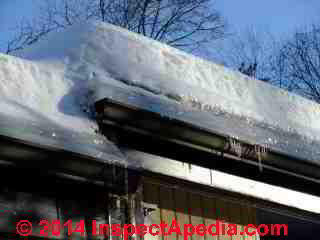 Lots of folks have seen gutters on the ground or hanging by one nail from homes in snow country, and in some locales people just give up on gutters entirely, relying on other methods to get roof runoff away from the building.
Lots of folks have seen gutters on the ground or hanging by one nail from homes in snow country, and in some locales people just give up on gutters entirely, relying on other methods to get roof runoff away from the building.
Here we illustrate a more subtle gutter failure: the roof gutter was well secured to the building, covered with a screen, and built to withstand a bit of snow curling over and falling off of the roof edge.
Or so the designers thought. And indeed on some roof areas this strategy works just fine (at left).
But if we skip the obvious cases of gutters ripped clean off of the building by snow and ice slides, what about gutter snafu's that are not so visible from ground level?
Our photo at below left illustrates a couple of points:
First, gutter screens slow the gutter clog rate they do not prevent gutter clogging - ever. The gutter screen design should include easy removal for cleaning.
While the gutter screen had kept leaves out of the gutter, the crud in this gutter consisting of dirt washing down from the roof and small organic debris particles was the accumulation of about four years.
Just sending this fine dirt on into the downspout is ok on a system that drains to daylight and easy to clean, but for long buried downspout drain systems it's important to keep crud out of both the gutter and the downspout drain system.
Details about this gutter and its screen are at GUTTER SCREENS but I wouldn't' go there right now. Let's stick to ice and snow damage.
Second, even modest snow an ice sliding off of a roof is likely to leave the gutter bent downwards, eventually popping most of its support brackets. This particular gutter was additionally secured to the fascia so it wouldn't fall off of the structure.
In a forensic detail worth noticing, the dirt in the gutter was accumulated at its forward edge (visible in the second photo at below right) meaning that the gutter had been somewhat bent by those earlier years of presumed-innocent snow and ice slides down the roof.
As this is more than one season's worth of crud in the gutter I think this gutter had been bent down for some time before this investigation.
Our third gutter photo above shows the gutter after it had been carefully straightened and its mounting clips re-used.
We did not replace the perforated screen as the contractor (Eric Galow, Galow Homes) intended to add more gutter supports.
See SNOW & ICE DAMAGE to GUTTERS for details about gutter damage where snow guards may have been a better idea.
Damage to the snow fence from snow loading
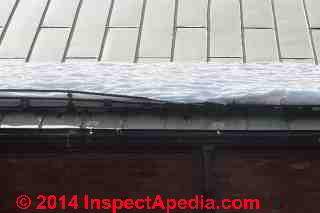 Our photo at left shows that even if the snow fence or snow guard stays in place it may be damaged by large snow loads, particularly deep snow followed by rain or perhaps rain and freeze cycles.
Our photo at left shows that even if the snow fence or snow guard stays in place it may be damaged by large snow loads, particularly deep snow followed by rain or perhaps rain and freeze cycles.
This bent snow-fence on a high metal roof that itself holds a large area of snow (thus produces high snow loading on the snow fence) might have survived without damage if:
- The snow guard supports had been spaced on a smaller interval
- Additional rows of snow guards or snow fencing had been placed at intervals higher on the roof slope.
Improper Snow Guard & Fence Location
The snow fence and glue-on snow guards on the building shown at above left are not properly located.
The lowest row of snow brake, fence, or snow guards on a roof should be placed over the building exterior wall.
These snow guards are all located on the roof extension, overhang, or eaves. I didn't see any damage to the roof structure from snow-loading, but then this is a pretty small overhang. on larger roof overhangs the risk of snow load damage would be greater.
At a large roof overhang such as Paul Galow's roof shown at above right, snow guards located past the exterior wall might be asking for trouble.
...
Continue reading at SNOW GUARD MOUNTING METHODS or select a topic from the closely-related articles below, or see the complete ARTICLE INDEX.
Or see these
Snow Guard & Snow Brake Articles
- METAL ROOFING
- ROOFING INSPECTION & REPAIR - roofing home page
- SLATE ROOF INSPECTION & REPAIR - home
- SLATE ROOF HARDWARE
- SNOW GUARDS & SNOW BRAKES
Suggested citation for this web page
SNOW GUARD FAILURES at InspectApedia.com - online encyclopedia of building & environmental inspection, testing, diagnosis, repair, & problem prevention advice.
Or see this
INDEX to RELATED ARTICLES: ARTICLE INDEX to BUILDING ROOFING
Or use the SEARCH BOX found below to Ask a Question or Search InspectApedia
Ask a Question or Search InspectApedia
Try the search box just below, or if you prefer, post a question or comment in the Comments box below and we will respond promptly.
Search the InspectApedia website
Note: appearance of your Comment below may be delayed: if your comment contains an image, photograph, web link, or text that looks to the software as if it might be a web link, your posting will appear after it has been approved by a moderator. Apologies for the delay.
Only one image can be added per comment but you can post as many comments, and therefore images, as you like.
You will not receive a notification when a response to your question has been posted.
Please bookmark this page to make it easy for you to check back for our response.
IF above you see "Comment Form is loading comments..." then COMMENT BOX - countable.ca / bawkbox.com IS NOT WORKING.
In any case you are welcome to send an email directly to us at InspectApedia.com at editor@inspectApedia.com
We'll reply to you directly. Please help us help you by noting, in your email, the URL of the InspectApedia page where you wanted to comment.
Citations & References
In addition to any citations in the article above, a full list is available on request.
- [1] Berger Snow Retention Systems, Berger Building Products, 805 Pennsylvania Blvd.
Feasterville, PA 19053
Toll-free: 800-523-8852805,
Email: info@bergerbuildingproducts.com, Website: BergerBuildingProducts.com
See: http://www.bergerbuildingproducts.com/pdfs/catalog_snowguards.pdf - [2] Precision Snow-Guards, AceClamp®, Standing Seam Metal Roof Supplies, Precision Snow-guards™ - c/o PMC Industries, Inc. 87 Spring Lane, Plainville, CT 06062 Tel: (860) 229-SNOW (7669) provides clear or colored plastic snow guards for metal and rubber roofs, available in "King" and "Queen" sizes. Tel: (860) 229-SNOW (7669). Website: http://www.snow-guards.com/snowguards.php
- [3] S-5!® Snow Retention Systems, S-5! Attachment Solutions,
Metal Roof Innovations, LTD.
8655 Table Butte Road
Colorado Springs, CO 80908
(888) 825-3432, Email: info@s-5.com, Website: http://www.s-5.com/snow/
The company's products include milled solid block aluminum snow rail mounting clamps of varying shapes & designs. We are evaluating the S-5! clamps provided by this company. These clamps attach to the standing seams on a metal roof and in turn are used to attach a snow rail or snow fence. The company also provides solar panel hold-downs for metal roofs.- Ed. - [4] SnoBar™, Tel: 800-711-9724, Website: http://www.snobar.com/index.html The company's products include a patented one-piece roof clamp bracket & other brackets for attaching bars used as snow rails or snow fences. No street address was provided.
- [5] Alpine SnowGuards® 289 Harrel Street Morrisville, VT 05661 Tel: 888-766-9994, Email: info@alpinesnowguards.com Website: http://www.alpinesnowguards.com/ [No direct retail sales]
- [6] ATAS Snow Retention Products, ATAS Headquarters Allentown, Pennsylvania 18106 Phone: 800-468-1441 FAX: 610-395-9342 Email: info@atas.com, Website: http://www.atas.com/Company/Contact.aspx
- [7] Pacific Sheet Metal, Aspen Office & Shop, 401 Aspen Airport Business Center Aspen, Colorado 81611, Email: sales@pacificsheetmetal.net, Tel: 970.925.2454. The company provides a line of very sturdy snow rails or fences that mount to the seams of a metal roof.
- [8] Gough Snow Guards, Brookfield IL, Tel: 708-485-6272, Website: http://www.snoguard.com/ The company's products include copper snow guards installed on slate roofs and tile roofs, as well as standing seam metal roof snow retention systems.
- [9] AMSI Supply 4333 Lynwood Ct, Douglasville, GA 30134, metal roofing components, Tel: 800-943-9771
- [10] SnowGrip, 126 Woodward Ave., Iron Mountain, MI 49801, Tel: 06-396-7000, Email: mark@snowgripit.com Website: http://www.snowgripit.com/
- [15] Eric Galow, Galow Homes, Lagrangeville, NY. Mr. Galow can be reached by email: ericgalow@gmail.com or by telephone: 914-474-6613. Mr. Galow specializes in residential construction including both new homes and repairs, renovations, and additions.
- [17] "From Asbestos to Zinc, Gutters", Technical Preservation Services, National Park Service, U.S. Department of the Interior, web search 9./29.10, original source: http://www.nps.gov/history/hps/tps/roofingexhibit/gutters.htm
- [19] Asphalt Roofing Residential Manual from ARMA the Asphalt Roofing Manufacturers Association Website https://www.asphaltroofing.org/product/residential-asphalt-roofing-manual/ ,
- [20] Terry Anderson, "Snow Retention - the Invisible Code", web search 7/13/12, original source: http://snow.tra-mage.com/news-articles/snow-retention-the-invisible-code.html [copy on file as: Anderson Dec 2011 Interface.pdf ]
- Building Pathology, Deterioration, Diagnostics, and Intervention, Samuel Y. Harris, P.E., AIA, Esq., ISBN 0-471-33172-4, John Wiley & Sons, 2001 [General building science-DF] ISBN-10: 0471331724 ISBN-13: 978-0471331728
- Building Pathology: Principles and Practice, David Watt, Wiley-Blackwell; 2 edition (March 7, 2008) ISBN-10: 1405161035 ISBN-13: 978-1405161039
- Built-Up Roof Systems, Manual, C.W. Griffin, Mcgraw-Hill (Tx); 2nd edition (July 1982), ISBN-10: 0070247838, ISBN-13: 978-0070247833
- Concrete Folded Plate Roofs, C. Wilby PhD BSc CEng FICE FIStructE (Author), Butterworth-Heinemann, 1998, ISBN-10: 0340662662, ISBN-13: 978-0340662663
- Concrete Roofing Tile, History of the, Batsford, 1959, AISN B000HLLOUC (available used)
- Copper Roofing, by CDA
- Copper Roofing, Master specifications for copper roofing and sheet metal work in building construction: Institutional, commercial, industrial, I.E. Anderson, 1961 (hard to find)
- Corrugated Iron, Building on the Frontier, Simon Holloway
- Handbook of Building Crafts in Conservation, Jack Bower, Ed., Van Nostrand Reinhold Company, NY 1981 ISBN 0-442-2135-3 Library of Congress Catalog Card Nr. 81-50643.
- Historic Preservation Technology: A Primer, Robert A. Young, Wiley (March 21, 2008) ISBN-10: 0471788368 ISBN-13: 978-0471788362
- Historic Slate Roofs : With How-to Info and Specifications, Tina Skinner (Ed), Schiffer Publishing, 2008, ISBN-10: 0764330012 , ISBN-13: 978-0764330018
- Low Slope Roofing, Manual of, 4th Ed., C.W. Griffin, Richard Fricklas,
McGraw-Hill Professional; 4 edition, 2006, ISBN-10: 007145828X, ISBN-13: 978-0071458283
- Roof failure causes in depth (and specific methods for avoiding them)
- Roof design fundamentals and flourishes, based on voluminous industry research and experience
- New technologies and materials -- using them safely and correctly
- Comprehensive coverage of all major roofing systems pecifications, inspection, and maintenance tools for roofing work
- Metal Roofing, an Illustrated Guide, R.A. Knowlton , [metal shingle roofs],
- Problems in Roofing Design, B. Harrison McCampbell, Butterworth Heineman, 1991 ISBN 0-7506-9162-X (available used)
- Roofing The Right Way, Steven Bolt, McGraw-Hill Professional; 3rd Ed (1996), ISBN-10: 0070066507, ISBN-13: 978-0070066502
- Slate Roofs, National Slate Association, 1926, reprinted 1977 by Vermont Structural Slate Co., Inc., Fair Haven, VT 05743, 802-265-4933/34. (We recommend this book if you can find it. It has gone in and out of print on occasion.)
- Roof Tiling & Slating, a Practical Guide, Kevin Taylor, Crowood Press (2008), ISBN 978-1847970237,
- The Slate Roof Bible, Joseph Jenkins, www.jenkinsslate.com, 143 Forest Lane, PO Box 607, Grove City, PA 16127 - 866-641-7141 (We recommend this book).
- Tile Roofs of Alfred: A Clay Tradition in Alfred NY
- Wood Shingle Roofs, Care and Maintenance of wood shingle and shake roofs, (EC), Stanley S. Niemiec (out of print)
- Our recommended books about building & mechanical systems design, inspection, problem diagnosis, and repair, and about indoor environment and IAQ testing, diagnosis, and cleanup are at the InspectAPedia Bookstore. Also see our Book Reviews - InspectAPedia.
- In addition to citations & references found in this article, see the research citations given at the end of the related articles found at our suggested
CONTINUE READING or RECOMMENDED ARTICLES.
- Carson, Dunlop & Associates Ltd., 120 Carlton Street Suite 407, Toronto ON M5A 4K2. Tel: (416) 964-9415 1-800-268-7070 Email: info@carsondunlop.com. Alan Carson is a past president of ASHI, the American Society of Home Inspectors.
Thanks to Alan Carson and Bob Dunlop, for permission for InspectAPedia to use text excerpts from The HOME REFERENCE BOOK - the Encyclopedia of Homes and to use illustrations from The ILLUSTRATED HOME .
Carson Dunlop Associates provides extensive home inspection education and report writing material. In gratitude we provide links to tsome Carson Dunlop Associates products and services.


